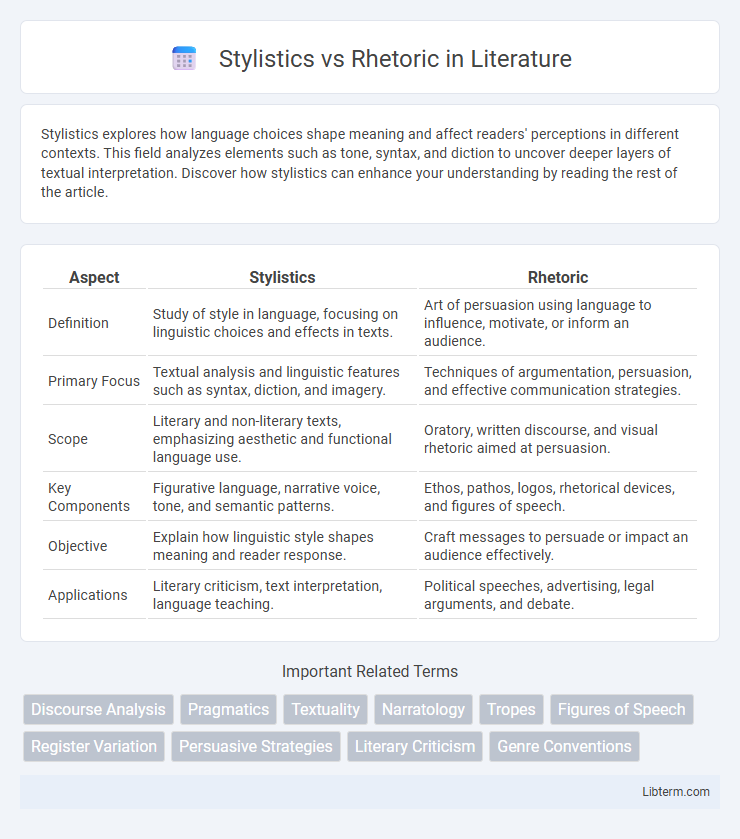Stylistics explores how language choices shape meaning and affect readers' perceptions in different contexts. This field analyzes elements such as tone, syntax, and diction to uncover deeper layers of textual interpretation. Discover how stylistics can enhance your understanding by reading the rest of the article.
Table of Comparison
| Aspect | Stylistics | Rhetoric |
|---|---|---|
| Definition | Study of style in language, focusing on linguistic choices and effects in texts. | Art of persuasion using language to influence, motivate, or inform an audience. |
| Primary Focus | Textual analysis and linguistic features such as syntax, diction, and imagery. | Techniques of argumentation, persuasion, and effective communication strategies. |
| Scope | Literary and non-literary texts, emphasizing aesthetic and functional language use. | Oratory, written discourse, and visual rhetoric aimed at persuasion. |
| Key Components | Figurative language, narrative voice, tone, and semantic patterns. | Ethos, pathos, logos, rhetorical devices, and figures of speech. |
| Objective | Explain how linguistic style shapes meaning and reader response. | Craft messages to persuade or impact an audience effectively. |
| Applications | Literary criticism, text interpretation, language teaching. | Political speeches, advertising, legal arguments, and debate. |
Introduction to Stylistics and Rhetoric
Stylistics studies language use and style in texts, analyzing linguistic features such as syntax, semantics, and phonetics to uncover meaning and effect. Rhetoric centers on persuasion techniques, exploring how language choices influence audience attitudes and behavior through ethos, pathos, and logos. Both disciplines intersect in examining language function but differ as stylistics emphasizes descriptive analysis, while rhetoric prioritizes strategic communication.
Defining Stylistics: Scope and Focus
Stylistics explores the systematic study of style in language, analyzing linguistic features such as syntax, phonology, and semantics to uncover how meaning and aesthetic effects are produced in texts. It focuses on both literary and non-literary genres, emphasizing the writer's or speaker's linguistic choices and their impact on interpretation. Unlike rhetoric, which centers on persuasion and argumentation strategies, stylistics prioritizes the detailed examination of language form and function within communication.
Understanding Rhetoric: History and Purpose
Rhetoric, originating in ancient Greece with Aristotle's foundational works, is the art of persuasion aimed at influencing audience beliefs and actions through effective communication. Its purpose extends beyond mere style, focusing on ethos, pathos, and logos to construct compelling arguments in political, legal, and social contexts. Understanding rhetoric involves analyzing how language choices shape meaning and impact, distinguishing it from stylistics, which primarily examines form, style, and linguistic features of texts.
Key Differences between Stylistics and Rhetoric
Stylistics analyzes the use of language and literary devices to interpret texts, focusing on linguistic features such as syntax, diction, and phonology. Rhetoric centers on persuasion, examining strategies like ethos, pathos, and logos to influence an audience effectively. While stylistics emphasizes textual analysis and linguistic form, rhetoric prioritizes audience impact and the art of argumentation.
Methods and Approaches in Stylistics
Stylistics employs linguistic analysis methods such as phonology, syntax, semantics, and pragmatics to examine literary texts, focusing on language use and style to uncover meaning and effect. Techniques include close reading, corpus analysis, and comparative studies to identify patterns, deviations, and stylistic devices within texts. In contrast, rhetoric primarily centers on persuasive strategies, emphasizing ethos, pathos, and logos to influence audiences, making stylistics more analytical and linguistically driven in its approach.
Techniques and Strategies in Rhetoric
Rhetoric employs persuasive strategies such as ethos, pathos, and logos to influence audience perception and action, contrasting with stylistics, which analyzes language features and textual effects. Key rhetorical techniques include repetition, metaphor, and rhetorical questions, designed to reinforce arguments and evoke emotional responses. The strategic use of these devices enhances message clarity and impact, making rhetoric a dynamic tool for effective communication and persuasion.
Applications of Stylistics in Literary Analysis
Stylistics in literary analysis involves examining linguistic features such as syntax, diction, and figurative language to uncover deeper meanings and authorial intent within a text. Unlike rhetoric, which focuses on persuasive techniques and audience appeal, stylistics emphasizes the structural and aesthetic elements that contribute to a work's overall effect and thematic development. This method enables scholars to interpret narrative voice, tone, and stylistic nuances, enhancing the understanding of literary artistry and cultural context.
Rhetoric in Everyday Communication
Rhetoric in everyday communication involves the strategic use of language to persuade, inform, or motivate audiences effectively, emphasizing clarity, emotional appeal, and credibility. It utilizes techniques such as ethos, pathos, and logos to enhance the impact of verbal and written exchanges in personal and professional contexts. Understanding rhetoric enables individuals to craft compelling messages that influence opinions and foster meaningful interactions.
Intersections: Where Stylistics Meets Rhetoric
Stylistics and rhetoric intersect in their shared emphasis on language choices that influence audience perception and engagement, with stylistics analyzing linguistic features and rhetoric focusing on persuasive strategies. Both disciplines explore how tone, diction, and syntax shape meaning and impact communication effectiveness across spoken and written texts. This convergence is evident in literary criticism, discourse analysis, and public speaking, where stylistic precision enhances rhetorical appeal.
Conclusion: The Importance of Both Disciplines
Stylistics and rhetoric together enrich communication by blending linguistic analysis with persuasive technique. Stylistics deciphers the intricate patterns of language use in texts, while rhetoric focuses on crafting messages that influence audiences effectively. Their combined study enhances both the interpretation and creation of impactful discourse across diverse contexts.
Stylistics Infographic

 libterm.com
libterm.com